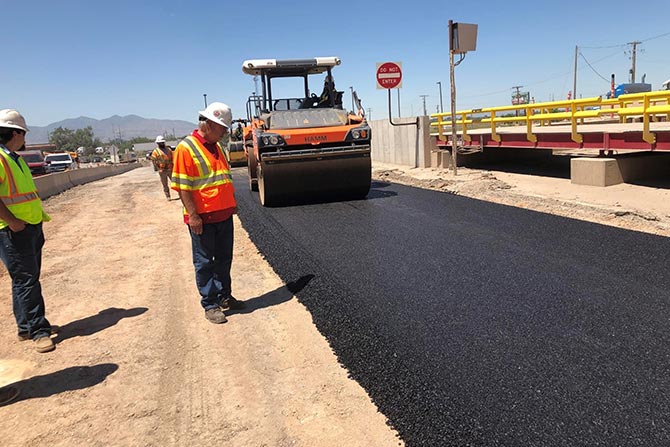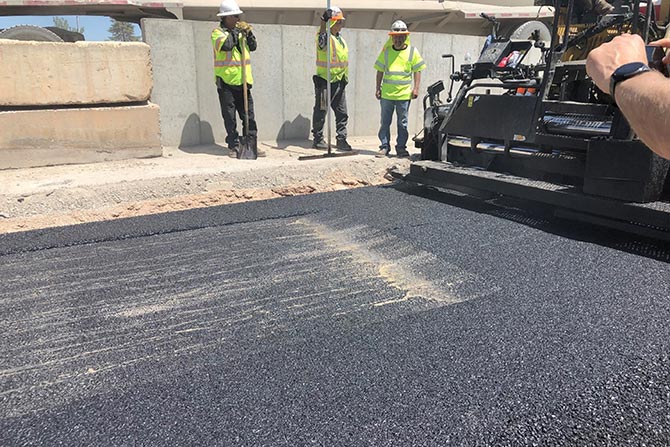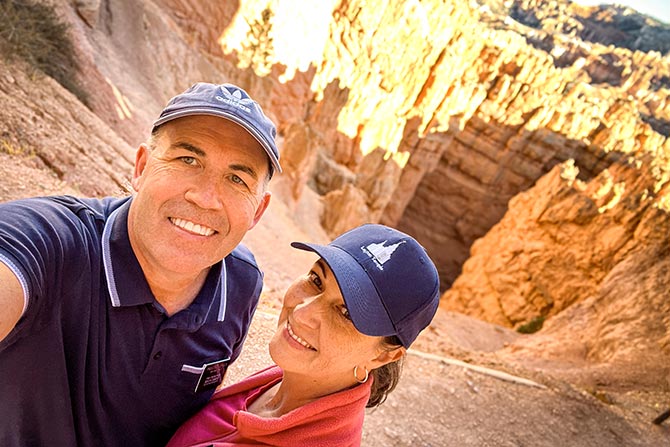Utah is known for its beautiful landscape and four distinctive seasons, but in some circles, there are five seasons: spring, summer, winter, fall and pothole season. Drivers in Utah know all too well the adventure of dodging potholes in efforts to save their car’s suspension.
In 2023 alone, Salt Lake City repaired over 38,000 potholes. Provo City, on average, uses 150 tons of asphalt per year to keep potholes repaired. Those are only two examples; the other 327+ cities in Utah have their own story to tell, and it all adds up to money spent.
Additionally, with more roadways being built each year to keep up with Utah’s fast-growing population and the ongoing need for regular road maintenance, asphalt crews have their work cut out for them.
The asphalt industry works hard — day and night — to keep roadways safe and free from hazards, like potholes, that can cause car damage and frustrate drivers. Keeping our roads in good repair may sometimes feel like an uphill battle.
In June, the Utah Department of Transportation (UDOT) shared some exciting news with the asphalt industry and citizens alike. The announcement garnered a lot of excitement as UDOT explained they had developed a weather-resistant, durable asphalt mix that would transform the way Utah is maintaining and repaving roads — reducing paving costs, time and repairs.
In asphalt mixes, crushed rock is mixed with binders that act as glue. UDOT’s new asphalt blend, called HiMod high-density asphalt (HiMod), uses a significantly higher ratio of polymer in the asphalt binder than traditional asphalt mixes. The thicker, stickier result is much stronger than previously possible, meaning less wear and tear on the roads.
This all started in 2013 when UDOT’s State Asphalt Engineer, Howard Anderson, learned about the new binder while attending a Federal Highway meeting. Howard came home with his curiosity piqued. He started working with UDOT’s binder suppliers and conducted tests, hoping to find a better way of maintaining Utah’s roadways.
The first test was conducted on State Route 191 in 2015 and then on U.S. 6 near Soldier Summit. These two projects were dropped in at the standard mix design contents. From these projects, UDOT learned how to pump the HiMod binder and better control the formulation. From there, adjustments were made, and formulas were refined by their binder suppliers in an effort to get the blend right.
Hamburg Rut Testing conducted by Clark Allen, UDOT’s Central Lab Mix Manager, proved the design could be drastically changed to allow for high binder contents and low void conditions that would facilitate a much more durable mix and thicker lift compaction.
In June of 2021, after years of refinement, the new HiMod blend was placed by Lonnie Marchant, Region 2 Materials Engineer, at the I-80 Wendover Port of Entry near the border of Utah and Nevada. The test site was selected for its extremities: Temperatures regularly reach the triple digits in the summer and the single digits in the winter, and the port of entry experiences heavy truck traffic regularly decelerating and accelerating, adding to pavement distress. In the past, the area has required regular pavement maintenance. Now in its fourth summer, the HiMod test site is still holding strong.
“This new mixture defies everything I studied about asphalt in school,” Howard said. “But what I was taught in school was based on binders of the past, before we had polymers. With stronger glue, it didn’t make sense to keep doing the same things we’ve always done with asphalt. I wanted to do something better.”
In addition to being durable, the blend can cut the paving process in half. With traditional asphalt mixes, crews often lay down the pavement in two thin layers, called “lifts.” This allows them to roll the pavement evenly throughout, compacting the asphalt and removing air pockets to make it more durable. This two-layer application means that crews must place one layer down, compact it, wait for it to set, test it and add an adhesive coating before repeating the process with another layer.
HiMod allows crews to do up to a single, six-inch lift without compromising compaction. Samples from the test site showed even compaction throughout, with much higher compaction rates than traditional asphalt mixes. This translates to stronger, more durable roads with half the labor.
Howard is not done testing his team’s mix. He wants to analyze it in even thicker lifts, as high as eight inches, and believes that that may be the key to creating “perpetual pavement.” And he isn’t limiting his plans to highways.
“This mix sets up faster than concrete and is more durable than traditional asphalt, and we can use it on sidewalks, trails, you name it,” Howard said. “Asphalt has stayed in its lane, so to speak, for decades, but it’s time for us to step it up and move beyond that. This mix opens so many opportunities for the asphalt industry as a whole.”
Lonnie quickly recognized the value of the new mix and immediately began placing it on other projects. Jason Simmons, UDOT’s Statewide Pavement Design Engineer, further tested it when he placed the mix directly on old concrete on I-15 near Parish Lane in early May of 2022.
Approximately 500,000 tons of HiMod have gone out this summer to be used on a dozen projects, including the I-80 ramps near the Salt Lake City International Airport, on I-80 going up Parleys Canyon and on MP 41 to 50 and repaving the I-215 eastbound off-ramp to State Street.
This is just the beginning. Other state departments of transportation have reached out to UDOT about adopting the mix because of their bigger pothole problems across their cities and counties due to the use of non-state specifications. UDOT officials expect to see it spread past Utah’s borders over the next few years.
“At UDOT, we’re always looking at ways to extend the life of our roads and save taxpayer money,” said Howard. “Changing something as simple as the materials used in our asphalt mix can have a tremendous impact, with fewer potholes and longer-lasting roads.”
The future of Utah’s roads looks bright, all thanks to a little curiosity, a binder and mix lab and a lot of hard work.
Get to know more about the HiMod project and the heroes who made this happen by clicking the link.


These two HiMod thick lift pictures were taken at the Staker Parson Materials & Construction Beck Street Plant the day before the Wendover POE test strip was placed in early June of 2021. Staker made history with this 100-ton test strip they placed on their own to help them be successful with the UDOT demonstration project the next day.







